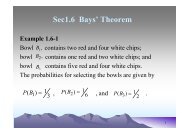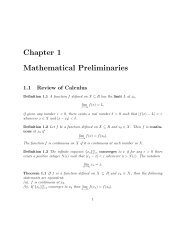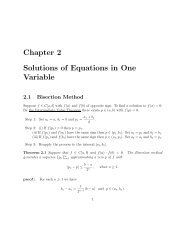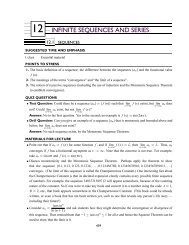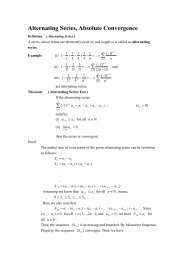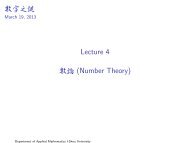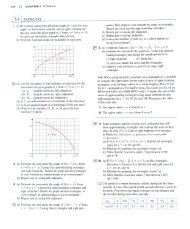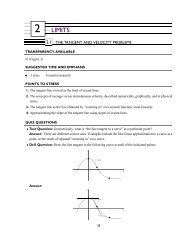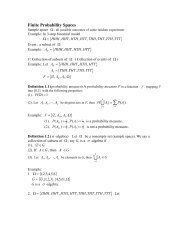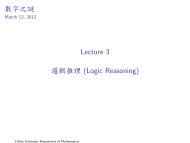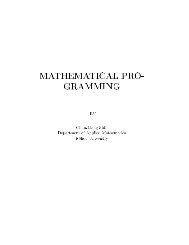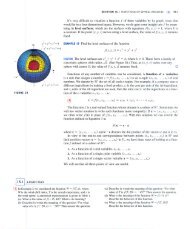[ill x = j .JY (y - 3),
[ill x = j .JY (y - 3),
[ill x = j .JY (y - 3),
Create successful ePaper yourself
Turn your PDF publications into a flip-book with our unique Google optimized e-Paper software.
[[] (a) Explain why the function whose graph is shown is a probability<br />
density function.<br />
(b) Use the graph to find the following probabilities:<br />
(i) P(X < 3) (ii) P(3 "" X "" 8)<br />
(c) Calculate the mean.<br />
y<br />
0.2<br />
9. Show that the median waiting time for a phone call to the company<br />
described in Example 4 is about 3.5 minutes.<br />
10. (a) A type of lightbulb is labeled as having an average lifetime<br />
of 1000 hours. It's reasonable to model the probability of<br />
failure of these bulbs by an exponential density function<br />
with mean J.L = 1000. Use this model to find the probability<br />
that a bulb<br />
(i) fails within the first 200 hours,<br />
(ii) bums for more than 800 hours.<br />
(b) What is the median lifetime of these lightbulbs?<br />
II. The manager of a fast-food restaurant determines that<br />
the average time that her customers wait for service is<br />
2.5 minutes.<br />
(a) Find the probability that a customer has to wait more than<br />
4 minutes.<br />
(b) Find the probability that a customer is served within the<br />
first 2 minutes.<br />
(c) The manager wants to advertise that anybody who isn't<br />
served within a certain number of minutes gets a free hamburger.<br />
But she doesn't want to give away free hamburgers<br />
to more than 2% of her customers. What should the advertisement<br />
say?<br />
12. According to the National Health Survey, the heights of adult<br />
males in the United States are normally distributed with mean<br />
69.0 inches and standard deviation 2.8 inches.<br />
(a) What is the probability that an adult male chosen at random<br />
is between 65 inches and 73 inches tall?<br />
(b) What percentage of the adult male population is more than<br />
6 feet tall?<br />
13. The "Garbage Project" at the University of Arizona reports<br />
that the amount of paper discarded by households per week is<br />
normally distributed with mean 4.3 kg and standard deviation<br />
1.9 kg. What percentage of households throw out at least 5 kg<br />
of paper a week?<br />
14. Boxes are labeled as containing 500 g of cereal. The machine<br />
f<strong>ill</strong>ing the boxes produces weights that are normally distributed<br />
with standard deviation 12 g.<br />
(a) If the target weight is 500 g, what is the probability that the<br />
machine produces a box with less than 480 g of cereal?<br />
(b) Suppose a law states that no more than 5% of a manufacturer's<br />
cereal boxes can contain less than the stated weight<br />
of 500 g. At what target weight should the manufacturer set its<br />
f<strong>ill</strong>ing machine?<br />
15. The speeds of vehicles on a highway with speed limit 100 km/h<br />
are normally distributed with mean 112 km/h and standard<br />
deviation 8 km/h.<br />
(a) What is the probability that a randomly chosen vehicle is<br />
traveling at a legal speed?<br />
(b) If police are instructed to ticket motorists driving 125 km/h<br />
or more, what percentage of motorists are targeted?<br />
16. Show that the probability density function for a normally distributed<br />
random variable has inflection points at x = J.L ::':: u.<br />
17. For any normal distribution, find the probability that the<br />
random variable lies within two standard deviations of the<br />
mean.<br />
18. The standard deviation for a random variable with probability<br />
density function f and mean J.L is defined by<br />
U = r~(x - J.LN(x) dx<br />
[ ]<br />
Find the standard deviation for an exponential density function<br />
with mean J.L.<br />
19. The hydrogen atom is composed of one proton in the nucleus<br />
and one electron, which moves about the nucleus. In the quantum<br />
theory of atomic structure, it is assumed that the electron<br />
does not move in a well-defined orbit. Instead, it occupies a<br />
state known as an orbital, which may be thought of as a<br />
"cloud" of negative charge surrounding the nucleus. At the<br />
state of lowest energy, called the ground state, or is-orbital,<br />
the shape of this cloud is assumed to be a sphere centered at<br />
the nucleus. This sphere is described in terms of the probability<br />
density function<br />
where ao is the Bohr radius (ao = 5.59 X 10- 11 m). The<br />
integral<br />
gives the probability that the electron w<strong>ill</strong> be found within the<br />
sphere of radius r meters centered at the nucleus.<br />
(a) Verify that per) is a probability density function.<br />
(b) Find lim,_~ per). For what value of r does per) have its<br />
maximum value?<br />
ffi (c) Graph the density function.<br />
(d) Find the probability that the electron w<strong>ill</strong> be within the<br />
sphere of radius 4ao centered at the nucleus.<br />
(e) Calculate the mean distance of the electron from the<br />
nucleus in the ground state of the hydrogen atom.<br />
1/2



